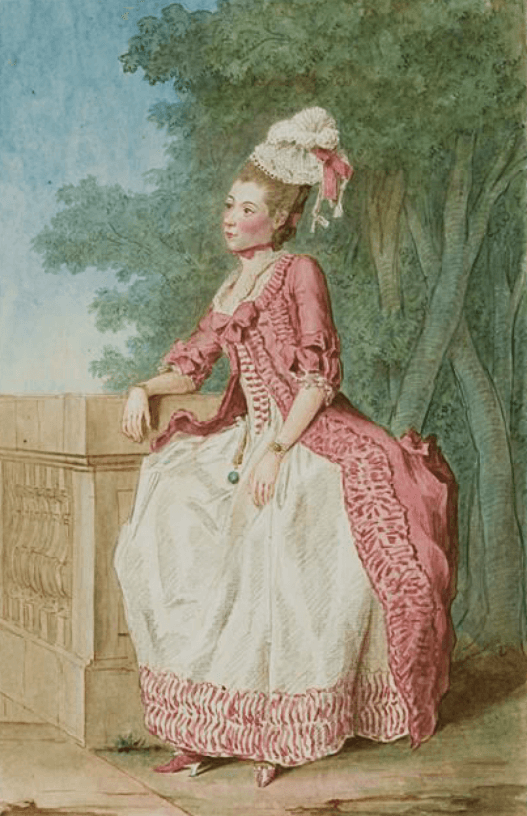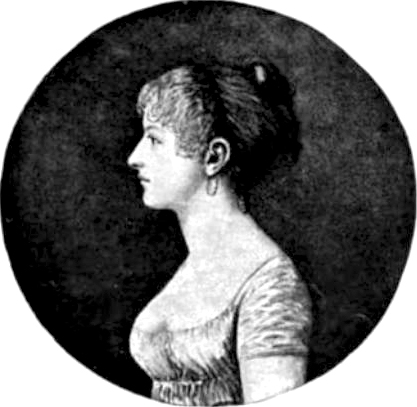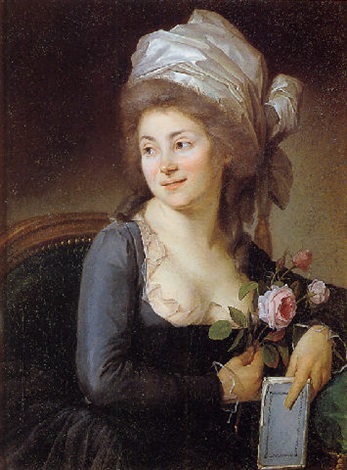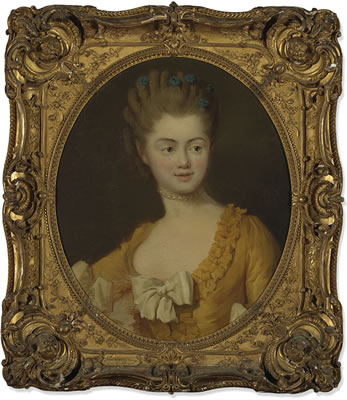
The large group of people clothed in chemises rouges or red smocks gathered together under the shade of the guillotine, were not there voluntarily. They were fifty-four men, women and teenagers, most of them not even known to each other. They had already endured the cries, insults and silent pity of the crowds as their tumbrils clattered along the cobbled streets of Paris on a three hour journey under the blistering sun, to where the executioner waited to take their heads. Their crime? Enemies of the Revolution.
The French revolution was not going well for Maximilien Robespierre. The Revolutionary Tribunal, of which he was the chief, had been created just over a year earlier, on 17 April 1793, and had certainly done its job in scaring the French and weeding out those hostile to the revolutionary cause. But it wasn’t enough. Robespierre, facing what he thought was a counter-revolutionary conspiracy supported by England, as well as fear of his own colleagues, wanted to use Terror as a general weapon of warfare.
Luckily for Robespierre, two attempted assassinations were made against him in May 1794. For both of them he wasn’t even there, but they allowed the revolutionary “fathers” to decry conspiracy and strengthen the laws in their favour. On 22 Prairial Year II (10 June 1794), a new law was passed which allowed denunciation to come in any shape or form, and denied suspects the right to a lawyer or a trial. You were either innocent or guilty, and if guilty, you went straight to the guillotine.
Several days later, Elie Lacoste presented a long and somewhat convoluted report to the Convention, based on evidence which was later refuted, that fifty-four individuals had colluded in a conspiracy, instigated by royalist Baron Jean de Batz, against the “fathers of the people”, culminating in the two assassination attempts by Cécile Renault and Henri Admiral.
It was a very remarkable document; compounded, in part, of every piece of stool pigeon’s gossip … so that what the Committees really believed and knew to be true is inextricably mixed up with what they pretended to believe and knew to be false
Meade Minnigerode, Marie Antoinette’s henchman – the career of Jean de Batz, 1936
There certainly were various conspiracies afoot – the enemies of Robespierre wanted him removed, England wanted to pick at the pieces of a disordered France, and Baron de Batz had tried to help the royal family escape. The fifty-four citizens were in some way associated with Batz (and if they weren’t, lies were written to make them so), and they all wanted an end to the revolution, but there was certainly no plans between them to kill Robespierre.
Incarcerated in prisons all over Paris, the 54 individuals were taken from their respective cells and brought to the Palais de Justice on 17 June 1794. Over the course of three hours, one by one, they were asked the same question: Did you have knowledge of or participate in the conspiracy? All 54 answered a definitive no. With no trial and no defence, all were found guilty and condemned to death by guillotine, to take place the same day. For the murder of Robespierre, a man who was quite alive and kicking at the time.
It was late afternoon by this stage. Nine horse-drawn charettes, including one for the women, waited patiently to take these “assassins” to their horrible fate. But it takes time to prepare someone for their execution. Hair must be shorn (and later sold for wigs), hands are tied, and garments trimmed around the neck to make sure the guillotine does its work smoothly. There are final requests to think of, and last minute trips to the bucket.
A witness commented that the women stood bravely, their composure commensurate with that of innocence. Public prosecutor Fouquier-Tinville, who was responsible for sentencing to death Charlotte Corday, Marie Antoinette and Olympe de Gouges, scathingly said: “see how brazen they are, I will go and watch them mount the scaffold, to see if they will retain this character, even if I miss my dinner”.
But the assassins were to be humiliated even further when forced to wear the chemises rouges. It was a tradition harking back to the ancien regime, before the revolution, where red shirts were worn by murderers, poisoners, assassins, for the crime of parricide. The fathers of the revolution kept traditions when it suited them; the red smocks were a visually startling reminder that blood would be shed for the cause, and it would not be theirs.
After a last-minute dash to a nearby draper to purchase a large swathe of red fabric which was cut in 54 pieces and wrapped around each prisoner, the convoy departed, preceded by cannons and guarded by gendarmes. After three long hours they arrived at their destination, place du Trône-Renversé, (renamed place de la Nation in 1880), the new site of execution. Despite not arriving until seven o’clock in the evening, the executioner Samson still had enough time to cut the heads of all 54 people before night fall. Some witnesses said it took only 28 minutes. Cécile Renault and Henri Admiral were the last to go.
Of those executed on 17 June 1794, known as the Affaire des chemises rouges, ten were women.
Cécile Renault, aged 20

Three weeks prior to her execution, on 22 May 1794, 20-year-old Cécile had walked from her home on Île de la Cite to the residence of Robespierre on rue Saint-Honore. He wasn’t home, so she sought permission to wait. As evening fell and she still waited, suspicions were raised – it had been less than a year since Charlotte Corday had stabbed the evil Jean-Paul Marat – and after a search of her person she was arrested for attempted assassination of a ‘father of the people’. Witnesses reported she was carrying a change of clothing (which she said was for her use in prison and then the guillotine) and several knives. When asked why she was waiting to see Robespierrre, she supposedly told them she “wanted to see what a tyrant was like”.
I would prefer one king to 500 tyrants
Cécile Renault, to the Revolutionary Tribunal
This was the story officially recorded in the archives of the Revolutionary Tribunal, purportedly extracted from Cecile Renault over hours of interrogation, and which she refused to sign even with a cross. She was entitled to no defence, or witnesses in her favour. Her lovely muslin and taffeta dress were taken from her and she was forced to wear filthy rags during the questioning. The deadly weapons, her two ‘knives’, were examined closely. They were in fact two pairs of sewing scissors, one with an ivory handle given as a gift by her brother and the other made of tortoiseshell which had belonged to her grandmother; hardly the weapons of choice for a cold-blooded assassination. As for the complete set of clothes, contemporaries recorded she was a seamstress and delivering finished pieces to clients.
Rumours abounded that she was the lover of Robespierre, but there is no evidence to support this. It is likely she merely stopped outside his house to see the man spoken of by all of Paris, and became embroiled in the political propaganda of the time.
Cécile sobbed when she was found guilty of parricide and sent for execution.
Edmée-Jeanne Renault, aged 62
The aunt of Cécile, a former nun, was arrested within a few days of Cécile’s supposed assassination attempt, in a horrible ploy to have Cécile admit to her crime. Since the closure of all convents and monasteries in 1790 she had lived with her brother and his children in Rue Babylone in Paris, and was beloved as a mother-figure to Céline. She was executed alongside her niece.
Cécile’s father, Antoine, aged 60, who owned a paper shop, and her brother, Antoine-Jacques, aged 31, were also arrested within days, and were amongst the 54 executed wearing the chemises rouges.
Marie-Suzanne Chevalier, aged 34

The day before Cécile supposedly thought about killing Robespierre, a man named Henri Admiral had shot at the deputy Collot-d’Herbois (responsible for the massacre of over 3500 people in Lyon in 1793), who was returning home late in the evening. Collot-d’Herbois was not seriously injured, but Admiral was arrested and taken to the guardhouse. During questioning by the Revolutionary Tribunal he allegedly stated he had been waiting to kill Robespierre but got impatient and shot Collot-d’Herbois instead. Robespierre wanted the two attempts, by Cécile Renault and Henri Admiral to be linked and considered a foreign conspiracy of which he was the target.
Marie-Suzanne Chevalier, or Madame Lamartinière, was arrested for her friendship with Admiral. According to questioning, she had lived in the same neighbourhood as Admiral for three years, and was supported financially by her husband, Salvador du Plessis Lamartinière, who was a soldier in the Pyrenees in the south of France. She said she knew Admiral only as an acquaintance as a week prior she had purchased a number of household items from his house – mattresses, serviettes, a bed of feathers, wool blankets, etc. for a total of 525 livres.
She recalled that several months earlier he had asked her for 50 pounds, produced a pistol from his pocket and announced “If you want to die, you only have to say, and I will kill you, and I have another pistol to kill myself afterwards”, then told her he was joking. When asked if she knew of his plans to shoot Collot-d’Herbois, she commented only that in the previous month she had pointed out to him to the house of her friend Collot-d’Herbois, in the same building as Admiral, and noted he was a good patriot.
According to historian Olivier Blanc, Marie-Suzanne Chevalier was sleeping with both Admiral and Collot-d’Herbois. On the night of the attempted “assassination”, the night which inadvertently led to the death of the 54, Admiral was drunk and shot at Collot-d’Herbois out of jealousy.
Madame Lamartinière, known to several members of the National Convention, was immediately arrested and placed in solitary confinement. In prison she proclaimed her innocence loudly; that she was a Robespierrest and she didn’t want to die. Within a month, she would be executed, along with Henri Admiral.
Jeanne-Françoise Desmiers de Saint-Amaranthe, aged 42

Jeanne-Françoise Desmiers de Saint-Amaranthe was well known to the Paris elite. Married young to a gentleman farmer who spent all her money on gambling and then deserted her, she had no trouble finding ‘patrons’, such as the Prince of Conti. An alluring and desirable woman who distinguished herself with her many lovers in Paris, she soon ran a gambling house or salon, with wealthy clients both of the aristocracy and in politics, including Robespierre’s younger brother, Augustin Robespierre. Its clientele would become a who’s who of the guillotined, and it was even rumoured Robespierre himself had attended. Having opened its doors in 1792, the salon at No. 50 Arcades du Palais-Royal (known as the “50”) was an immediate success. With its luxurious decoration and exquisite food, it became an essential haunt for Parisian society.
As long as you had money, your politics were irrelevant – until they weren’t. As the revolution turned nasty and in on itself, the salon and Madame Sainte-Amaranthe were denounced. Accusations of laundering forged overseas money and counter-revolutionary activity were made, and Madame Sainte-Amaranthe found her protectors were either in jail, dead, or had run for their lives.
I especially denounce Saint Amaranthe where the aristocrats gather… she is displeased with the true patriots who enter her home, and they are so reluctant to return because of her impertinence and her airs of grandeur which are so unsuitable for a woman who runs a gambling den.
Citizen Lormeaux
With her earnings she had purchased a house in the bucolic countryside, in Sucy en Brie in le Val-de-Marne, the Château de Chaumontel, which was denounced as a royalist hideout. It was here that she, her son and her daughter were arrested in April 1794 and sent to the prison Sainte-Pélagie. Interrogated by the committee for damaging information to use on counter-revolutionaries she was found to have had contact at one time or another with agents of the foreign conspiracy such as Baron de Batz.
Six weeks later, when found guilty and sentenced to die, she was inconsolable, and it was her daughter who gave her the strength to stand tall.
Charlotte-Rose-Émilie de Sainte-Amaranthe, aged 19

Considered the most beautiful woman in France, Émilie, the daughter of Madame Saint-Amaranthe, and a favourite of the attendees of the gambling salon, was already married to the dashing and dissolute Charles Sartine, son of a former minister to Louis XVI.
“Her face was oval, rare and perfect, but she was not a Greek beauty; she belonged to the elegance and refinement of the century of Louis XIV. Her figure was admirable, with its delicate proportions, her medium height, her walk and her poses combined both charming sophistication and graceful dignity”
Contemporary description by a friend of Madame Sartine
Upon her arrest, one of the rumours circling was that she had rejected the advances of Robespierre himself, who had then ordered her to be incarcerated. It was also said that the tyrant, his lips loosened after a wine-soaked dinner, had revealed to her his deepest desires to be king. This unfortunate young woman comforted her mother as they were led to their death. Her brother, 16 year old Louis Sainte-Amaranthe, and her husband, Charles Sartine, were also guillotined on the same day.
Marie Babin Grandmaison, aged 27

The committee of Public Safety was getting rather desperate over the whereabouts of Baron Batz. He had supposedly been seen in and around Paris, conspiring to bring back the monarchy and to destabilise the glorious revolution. His houses were searched, including his country pied-à-terre in Charonne on the then outskirts of Paris, where his mistress, Maria Grandmaison was living.
Maria was beautiful, a singer and actress with the Italian comedy or Opéra Comique . One of Maria’s performances, perhaps around 1786, had mesmerised Batz and they became lovers soon afterwards. Although they would never marry, she was said to have been the love of his life. The house in Charonne, private and discreet and far from the capital, was the perfect place to hide his amours, as well as serve as a meeting place for other royalists.
The residence was ransacked in September 1793, at 3 o’clock in the morning. But there was no Batz. It was rather strange – the cook had taken 12 whole minutes to answer the door, and ten beds had been slept in but only eight people were found. Had they really seen a figure slipping over the fence and into the night? The mayor, the chief prosecutor, the captain of the guard national and 200 men who conducted the search, were quite reluctant to leave empty-handed, and arrested everyone in the house instead.
Maria and her maid, Nicole Bouchard, were sent to the prison of Saint-Pélagie. Maria refused to implicate Batz, though he was so good at hiding that it was unlikely she knew anything anyway. Despite promises of liberty in exchange for information, Maria gave nothing away.
“You are seeking that man to put him to death, and you demand that his friends should deliver him to you? What infamy! I do not know his hiding place, I tell you, and if I did I would not reveal it to you”
Meade Minnigerode, Marie Antoinette’s henchman – the career of Jean de Batz, 1936
Nicole Bouchard, aged 18

Marie-Nicole Bouchard, companion or servant to Marie Grandmaison and aged only 18, was the tragic face of the affair of the chemises rouges. She was killed for no reason other than having lived in a house owned by Batz. When questioned about her master, she merely stated he visited the house sometimes two or three times a week.
When she was arrested, the men almost failed to do so, reporting: “this child should not die”. To Sanson the executioner she was so delicate and fragile, “a tiger would have pitied her”. The man who bound her wrists said “this is just a joke, isn’t it?”
‘No monsieur, it is real’, said Nicole.
Before leaving the Palais de Justice, a man refused to tie the cords and had someone else do it. In the journey to the scaffold Nicole asked to sit with her mistress, Maria Grandmaison, who was weeping, and did her best to give her comfort. As the tumbril containing the women rumbled past, the crowd vented its indignation: “No more children!”
Catherine-Suzanne Vincent, aged 45

A talented harpist and pianist, Catherine-Suzanne was married in 1766 to Francois-Marie Griois. However, the two became estranged. Griois, a royalist, was deeply involved in a 1792 plot to overthrow the regime, but because of his connections somehow escaped the internal purges of the Convention.
She was also the sister of neo-classical painter François André Vincent, and the two owned a sumptuous mansion in Paris on Rue de Ménars where they lived with Catherine’s two children and his lover, the artist Adélaïde Labille, whom he would later marry. (Elisabeth Vigée le Brun herself also had a studio in this enormous house). In this unconventional household were another two apartments, on separate floors, in which could be found Baron de Batz periodically when he was in Paris, and his mistress Marie Grandmaison.
The mere fact that Batz kept a room in this house was enough to implicate Madame Griois. A prison informer related that she knew all about the conspiracy created by Batz, which was a blatant lie, but was enough to have her included in the 54 to be executed.
Françoise-Augustine Duval d’Eprémesnil, aged 45

Born on the island of Bourbon, now Île de Réunion, she and her three sisters were sent to Paris by their widowed father when they were of marriageable age. Known for their ‘loose morals’, having been raised rather freely on the island, they were soon in the midst of high society, in their search for wealthy and powerful men. Françoise-Augustine was first married to parliamentarian Jacques de Thilorier, who died an accidental death in Bordeaux in 1783. It could not have been a happy marriage, as in 1778 she was installed as one of ‘six berceuses’ (lullabies), kept as concubines in the luxurious house of Nicolas Beaujon, who collected beautiful women as he collected art.
She met her second husband around this time, the rich and debonair Jean-Jacques Duval d’Eprémesnil, a lawyer in the Parliament of Paris. She and d’Eprémesnil eventually married, but had already been living openly with each other during her first marriage. Her husband, before his death, had turned a blind eye to the indiscretion and to the children who were not his, in exchange for borrowing large sums of money from d’Eprémesnil.
Once ensconced in Paris, her beauty and intelligence drew writers, actors, musicians and very important people to her elegant salon, which soon became one of the most prominent. Marie de Grandmaison was a visitor. The Baron de Batz, a close friend who married her daughter Michele Thilorier, often attended, as well as other known royalists. It was only a matter of time before the salon and the d’Eprémesnils were denounced. Despite the attention from authorities they refused to emigrate, and the end of 1793 saw them seeking respite in Normandy.
Jacques was arrested in December 1793. Madame d’Eprémesnil followed him to Paris, ostensibly to have her passport for travel inside France renewed, and she too was taken by the police. Kept waiting in a freezing room for thirteen hours with the lowest of society, she was eventually sent on to prison. Her two daughters and sister (who was also a mistress of Charles Sartine) would soon join her there.
Her husband was executed on 22 April 1794.
Madame d’Eprémesnil was included in the Batz conspiracy. Indeed, they were close friends, she was his mother in law, and the Tribunal set forth the argument that she therefore must have been aware of the assassination attempts. Judged without trial and without defence like the others, she bravely faced the executioner.
I have known her for 20 years, first in Bordeaux and then in Paris. She was extremely beautiful, as pretty as a picture, filled with charm and grace, and principles the same as her husband.
Count d’Antraigues
Anne-Madeleine-Lucile Parmentier de la Motte, aged 72

Prior to the revolution, Madame de Crécy had lived a life of luxury. Her husband was Alexandre Lemoine de Boullongne de Crécy, an assistant Intendant of the Garde-meuble de la Couronne, the department responsible for the purchase and maintenance of furniture and decoration for the royal residences, and her brother-in-law was the Intendant himself, residing at the Hôtel de la Marine on the place Louis XV (now place de la Concorde).
But with the fall of the monarchy, there were no royals or châteaux to look after. Her brother in law, Marc-Antoine Thierry, had been arrested in 1792, accused of having hidden some, but not all of the Crown Jewels, an exquisite collection worth millions, in a custom-made jewellery box with nine compartments. Alexandre de Crécy, her husband, was ordered to hand this box over, where it was placed under seal, unopened. However, in the chaos of revolutionary France, no one was watching its treasures, and the Crown Jewels were stolen from under the nose of guards.
It was not Madame de Crécy who stole the jewels, but denunciations and accusations did not always make sense in the revolution. If you were associated with royalty or the aristocracy, you were guilty, it didn’t really matter of what you were guilty. She was accused of having helped her husband and brother in law to steal the jewels on the orders of the king, Louis XVI, and having concealed them in a cabinet in the wall. Had her husband and/or brother in law taken some jewels? Most diamonds were found within a couple of years so it will never be known exactly what happened.
But Madame de Crécy, languishing in prison, was a perfect target to be added to the 54 conspirators. Somehow, she had supposedly helped to arrange the attack on Collot -d’Herbois, to eliminate one of the witnesses to the theft of the Crown Jewels. And then, according to prison informers, had not been happy enough that the attack failed.
Her servant, Jean-Baptiste Portebœuf was also executed on this day, denounced for not showing enough indignation at the attempted assassination of Collot-d’Herbois.
Her husband was sent to the guillotine several weeks later, on 7 July 1794.
Aftermath
In Paris, in the 14 months from the establishment of the Revolutionary Tribunal until the 10 June 1794, 2,607 patriots and aristocrats had been executed. From the new law of 22 Prarial until 27 July 1794, in the Reign of Terror, a period of only 46 days, 1,351 men, women and children perished.
But the people had had enough. The Great Terror had ceased to terrorise. The Parisians were sickened, overwhelmed, and running out of space to bury these enemies of the revolution. But Robespierre and his cronies themselves would soon be looking for a cemetery – they were disposed by a coup six weeks later and faced the same executioner as these ten brave women.

For several weeks after the Affaire des Chemises Rouges, it was the fashion for women to wear red shawls to show their beauty, and their support for the executed.
Further reading
Olivier Blanc, Les Libertines: Plaisir et liberté au temps des Lumières, Paris, 1997.
Olivier Blanc, Les Hommes de Londres, histoire secrète de la Terreur, Éditions Albin Michel, Paris, 1989
Meade Minnigerode, Marie Antoinette’s henchman – the career of Jean de Batz, 1936
E. Lairtullier, Les Femmes Célèbres de 1789 a 1795, Paris 1840
H. Wallon, Histoire du Tribunal Révolutionnaire à Paris, 1881



